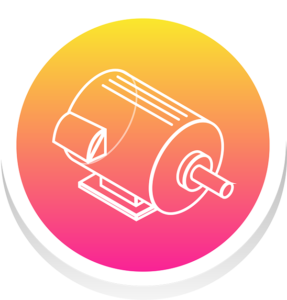Application Guidance: High Efficiency Motors
When selecting a motor, consider the following application guidance:
Motor Horsepower (HP)
Motor horsepower is one of the first things to consider when selecting a motor for a given application. The horsepower is the rated amount of power the motor can provide to your system. This can be broken down into the product of torque (or rotational force in foot pounds (ft-lb) or newton-meters (Nm)) and rotational speed in rotations per minute (RPM). You should choose a motor that is rated at or just above the maximum horsepower that you will need. If the motor is undersized (less HP than required) the motor life may be shorter or the motor may not function satisfactorily, if at all. If you choose a motor that is considerably oversized (much more HP than required) the motor will likely operate in a less efficient region.
Motor Speed (RPM) and Torque
Each type of application requires a different motor speed and torque. Selecting a motor that is as close to the speed and torque requirements of the application can reduce or eliminate the need for pulleys or other mechanical conversions to match speeds, and that reduce overall efficiency and add points of failure.
Supply Electrical Power
Another important thing to consider when purchasing a motor is matching it to the supply electrical power. This means matching the voltage, phase, and amperage capacity. Many motors operate at 3-phase 208 VAC. However, some operate with a supply voltage equivalent of 3-phase 480 VAC. Single phase 120 VAC or split phase 240 VAC are more common in light duty and residential applications. In addition to matching the voltage you must make sure that the building electrical service panel and wiring can supply the peak amperage that is required from the motor. When using a motor drive, a final thing to consider is the electrical requirements for that drive. In some cases, the drive requires a different electrical power specification than the motor and translates that power to the required electrical power for the motor.
Connection
The next important thing to consider is motor connection. This includes how and where the motor is mounted securely to a fixed point and how the rotor is connected. The frame designation with either 2 or 3 digits can give you some information on the mounting locations and rotor connection of the motor. To be confident that the motor will fit, you should find the dimensional information from the motor manufacturer and ensure that it matches your application.
Cost of Ownership
Cost of Ownership refers to the entire cost of owning the motor, not just the initial purchase cost. Three things should be considered when looking into cost of ownership: Efficiency, Purchase Cost, and Reliability. A more efficient motor can reduce electricity consumption and decrease utility costs. For applications where a motor can often run at a low speed and torque, selecting a variable speed motor and drive can greatly reduce electric energy consumption and utility costs. Over the life of the motor, energy savings can typically more than pay for the extra initial cost of an efficient and/or variable speed motor. Additionally, a reliable motor that has a long lifespan can reduce the cost of ownership by extending the time before having to buy and install a replacement motor.
